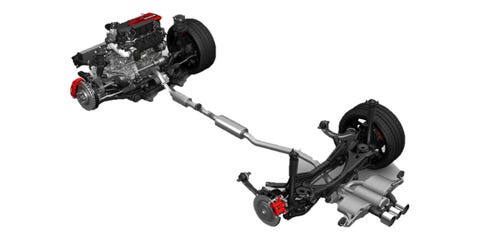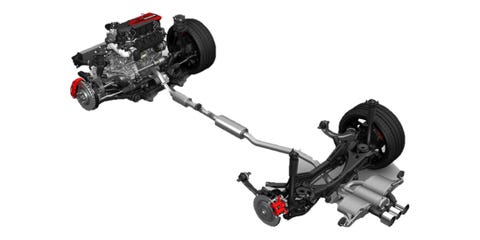Why the 2017 Honda Civic Type R Has Three Tailpipes
Here's what the small middle exhaust pipe on the Civic Type R actually does.

HONDA
BY BOB SOROKANICH
The 2017 Honda Civic Type R is here, and it's a knockout. The most hardcore Civic ever packs 306 turbocharged horses and claims to be the fastest front-drive car to ever lap the Nurburgring.
But what's up with that triple-tip exhaust? Some folks seem to think it's just an unnecessary styling feature, but it's much more than that—it's a precisely engineered, fully functional addition that's crucial to the Type R's aural experience. Road & Track spoke with Rob Keough, senior product planner for the 10th-generation Civic, to find out why a four-cylinder car is breathing through three tailpipes of two different diameters.

HONDA
"Traditionally with these big flow exhaust systems, when you get up into highway speeds, you can get a lot of droning, booming, buzzing—not very comfortable for high speed cruising," Keough told R&T. Honda wanted to offer a sporty, engaging sound in aggressive driving, without punishing drivers on long commutes or highway trips. And the automaker wanted to do so without resorting to stereo-enhanced engine sounds or complex (and expensive) multi-mode muffler systems.
The solution is to split the single exhaust into three pipes just behind the rear axle. The two outer pipes include large straight-flow mufflers. The center, smaller diameter pipe is a resonator, shaped and sized to perform a particular aural trick.

HONDA
At low speed—say, as you're full-throttle accelerating from a dead stop—some of the exhaust flows through the center resonator, generating a louder, more aggressive growl. "You'll hear it both outside and inside the car," Keough said. As you settle in to high speed cruising, the exhaust flowing through the center outlet hits a resonant frequency. The resonator gets stuffed with air, stalling the airflow; the resulting backpressure diverts the exhaust to flow exclusively through the larger outboard mufflers, reducing the cabin noise at highway speeds.
"It basically diminishes the resonator effect at that point, attenuating the sound inside the car," Keough said. "You still get your big flow through the outboard pipes, but you get a more refined in-cabin experience at high-speed cruising. " Under certain conditions, the center resonator can actually begin sucking air in, Keough said, creating a venturi effect flowing out through the outboard pipes.
"When it’s not flowing through the center resonator, it’s not generating that extra resonance. So it’s not like you have zero exhaust sound, but you’re not generating this extra sporty sound that comes from the resonator," Keough told R&T. Additional insulation and aerodynamic tweaks to the Civic Type R help reduce in-cabin noise on the highway even further.

HONDA
While the exhaust system precisely manipulates sound and flow based on RPM and speed, there are zero moving parts and no electronics involved. That stays in line with the Type R's identity as a raw, honest machine, not the type of vehicle where you'd expect to find faked exhaust notes coming through the stereo. It also helps keep the one-trim-level-only Civic Type R's sticker price in the $34,000 range. "We didn’t build in servos or flap valves," Keough said. "This is a very simply designed system where you’re getting the effect without additional moving parts. It's a very durable, low cost and effective solution."
Of course, the Civic Type R is the kind of car that aftermarket tuners love to fiddle with—especially now that it's coming to the US market for the very first time. I asked Keough if he'll be frustrated to see owners cutting out this painstakingly-engineered three-tip system and replacing it with a big, boomy exhaust.
"We kind of anticipate that," he said. "We wanted to deliver a high quality, sporty, but refined experience for this customer, but we already know some kids are gonna want more noise. We’re not going to be particularly offended."
No comments:
Post a Comment